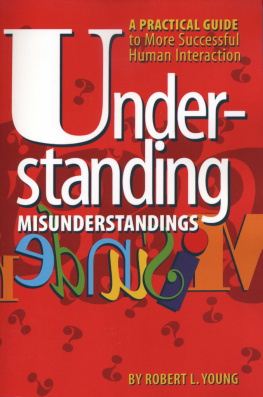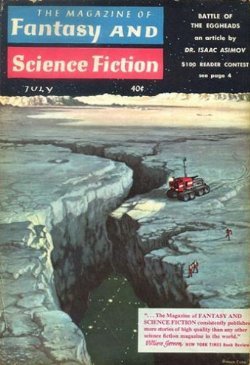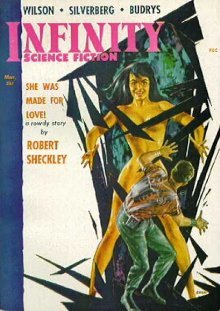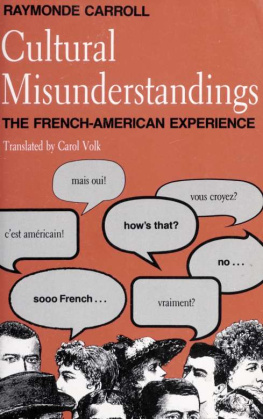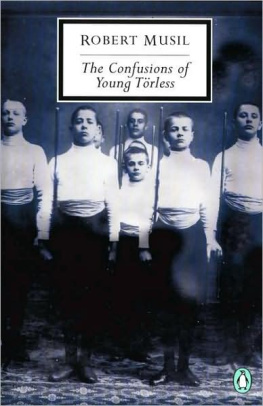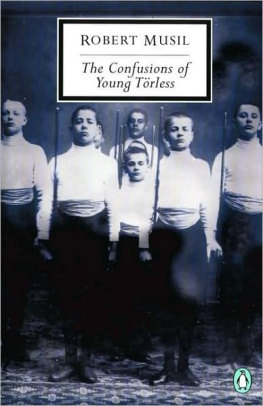Robert L. Young - Understanding Misunderstandings
Here you can read online Robert L. Young - Understanding Misunderstandings full text of the book (entire story) in english for free. Download pdf and epub, get meaning, cover and reviews about this ebook. year: 1999, publisher: University of Texas Press, genre: Religion. Description of the work, (preface) as well as reviews are available. Best literature library LitArk.com created for fans of good reading and offers a wide selection of genres:
Romance novel
Science fiction
Adventure
Detective
Science
History
Home and family
Prose
Art
Politics
Computer
Non-fiction
Religion
Business
Children
Humor
Choose a favorite category and find really read worthwhile books. Enjoy immersion in the world of imagination, feel the emotions of the characters or learn something new for yourself, make an fascinating discovery.
- Book:Understanding Misunderstandings
- Author:
- Publisher:University of Texas Press
- Genre:
- Year:1999
- Rating:3 / 5
- Favourites:Add to favourites
- Your mark:
- 60
- 1
- 2
- 3
- 4
- 5
Understanding Misunderstandings: summary, description and annotation
We offer to read an annotation, description, summary or preface (depends on what the author of the book "Understanding Misunderstandings" wrote himself). If you haven't found the necessary information about the book — write in the comments, we will try to find it.
Understanding Misunderstandings — read online for free the complete book (whole text) full work
Below is the text of the book, divided by pages. System saving the place of the last page read, allows you to conveniently read the book "Understanding Misunderstandings" online for free, without having to search again every time where you left off. Put a bookmark, and you can go to the page where you finished reading at any time.
Font size:
Interval:
Bookmark:
UNDERSTANDING MISUNDERSTANDINGS
A PRACTICAL GUIDE TO MORE SUCCESSFUL HUMAN INTERACTION
ROBERT L. YOUNG

UNIVERSITY OF TEXAS PRESS,
AUSTIN
is reproduced courtesy of Mark Snyder. It originally appeared in the article Self-Monitoring of Expressive Behavior in Journal of Personality and Social Psychology 30: 526537.
Copyright 1999 by the University of Texas Press
All rights reserved
First edition, 1999
Requests for permission to reproduce material from this work should be sent to Permissions, University of Texas Press, Box 7819, Austin, TX 78713-7819.
LIBRARY OF CONGRESS CATALOGING-IN-PUBLICATION DATA
Young, Robert L. (Robert Louis), 1949
Understanding misunderstandings : a practical guide to more successful human interaction / Robert L. Young. 1st ed.
p. cm.
Includes bibliographical references and index.
ISBN 978-0-292-79606-5
1. Miscommunication. 2. Interpersonal communication. I. Title.
BF637.C45Y69 1999
153.6dc21
99-13582
ISBN 978-0-292-75988-6 (library e-book)
ISBN 978-0-292-78658-5 (individual e-book)
DOI 10.7560/796058
To Louis and Louise; for Katie and Nick
CONTENTS
PREFACE
All social interaction is based on the assumption that whatever we say or do will be understood more or less as it was intended. It is clear, however, that the course of social interaction is often determined by misspeaks, mishearings, misinterpretations, and other forms of misunderstanding. When we misunderstand each other, we are likely to respond in inappropriate, unproductive, and sometimes destructive ways. Misunderstandings can produce frustration, embarrassment, shame, and misdirected anger, which can disrupt social interaction and sometimes damage interpersonal relationships. Understanding exactly how and why interpersonal misunderstandings come about can help us avoid them and more effectively handle them when they do occur.
Inasmuch as misunderstandings create practical problems, a book about them would seem to benefit from a practical approach. As an academic sociologist I am convinced that there is nothing more potentially practical than a good theory. Unfortunately, the literature of the social and behavioral sciences is replete with good theories and valuable insights that never find their way into public thinking and policy. Because those of us involved in scientific pursuits communicate with each other through the often esoteric languages of science and philosophy, most of what we produce in scholarly journals never finds its way into public discourse. Moreover, because most of us consider it our job to produce and critique knowledge, rather than apply it, we rarely attempt the difficult yet vital task of translating that knowledge into a language that is meaningful to professionals, community leaders, and other educated members of the public. This book is an attempt to do just that. It represents more than a decade of thinking and writing around and about a topic that I consider central to our ability to function effectively as social beings. The ideas presented here are drawn primarily from the disciplines of sociology, psychology, linguistics, and anthropology, and I hope that they adequately reflect my appreciation for the contributions of scholars from each of those disciplines.
In the interest of making the book appealing and informative to students and educated laypeople, I have sacrificed much of the depth and attention to detail characteristic of more scholarly work. Because of its breadth, however, I hope that even those scholars who find my coverage of the insights provided by their own discipline lacking will nevertheless benefit from exposure to the ideas that other disciplines bring to the topic. Inasmuch as I have documented the scholarly sources from which I have drawn, those interested in a more thoroughgoing and systematic study of the various topics on which I touch will have a place to start.
Many people deserve thanks for assistance and inspiration along the way. First and foremost, I thank those students, friends, and acquaintances who shared the personal experiences that constitute many of the examples that appear throughout the book. Their stories provided data for my analysis and gave life to my otherwise inadequate prose. In all cases, their names have been changed to preserve their anonymity. I also thank my department and university for the time and resources required to conduct such a project, as well as my colleagues, who helped direct me to sources of information in areas with which they were more familiar than I. Finally, to adequately thank Carol Thompson would require another book. Having suffered through this one, however, she would probably prefer a simple thanks.
CHAPTER ONE
Introduction
Interaction and Misunderstanding
(Costello) On the Saint Louis team we have Whos on first, Whats on second, I Dont Knows on third.
(Abbott) Thats what I want to find out I want you to tell me the names of the fellows on the Saint Louis team.
(Costello) I, Im telling you Whos on first, Whats on second, I Dont Knows on third.
(Abbott) You know the fellows names?
(Costello) Yes.
(Abbott) Well then, Whos playing first?
(Costello) Yes.
(Abbott) I mean, the fellows name on first base.
(Costello) Who.
(Abbott) The fellow playing first base for Saint Louis.
(Costello) Who.
(Abbott) The guy on first base.
(Costello) Who is on first.
(Abbott) Well, what are you asking me for?
(Costello) Im not asking you, Im telling you, Who is on first.
(Abbott) Im asking you: Whos on first?
UNIVERSAL PICTURES (1945)
Do you know anyone you just cant seem to communicate with, no matter how hard you try? If you make a joke, they take it seriously. If you pay them a compliment, they assume you have a hidden agenda. If you make a suggestion, they take it as an order. Such encounters are frustrating, and the results are usually not comedic. Whether such people are coworkers, acquaintances, or relatives, it seems that most of what you do or say passes through some sort of distortion filter before it registers on their brain, and it may not work any better as you try to make sense of their actions. In fact, it seems that one or both of you are in a perpetual state of confusion over just what has gone wrong, and you find yourself describing one after another of your interactions as a misunderstanding. It would be frustrating enough if such experiences were restricted to a few problem individuals we might be able to avoid much of the time. Unfortunately, we also experience such difficulties with people we know intimately and feel that we understand well. How does this happen? Can anything be done to avoid these exasperating experiences?
First, we must recognize that although interpersonal misunderstandings are among the more frustrating of life experiences, they are also among the more common. They are, quite simply, a part of the human condition. Shakespeares Romeo and Juliet was written four hundred years ago, but the tragic misunderstanding that marks the climax of that play still captures the imagination of romantics everywhere. In the final act, after mistaking his lovers feigned suicide for the real thing, a grief-stricken Romeo kills himself. Awakening to find her true love dead, Juliet completes the tragedy by taking her own life. Almost four centuries later, in 1934, Clark Gable and Claudette Colbert won Academy Awards for It Happened One Night, a story about star-crossed lovers who almost lost their chance at happiness because of a misunderstanding. In 1962
Next pageFont size:
Interval:
Bookmark:
Similar books «Understanding Misunderstandings»
Look at similar books to Understanding Misunderstandings. We have selected literature similar in name and meaning in the hope of providing readers with more options to find new, interesting, not yet read works.
Discussion, reviews of the book Understanding Misunderstandings and just readers' own opinions. Leave your comments, write what you think about the work, its meaning or the main characters. Specify what exactly you liked and what you didn't like, and why you think so.

